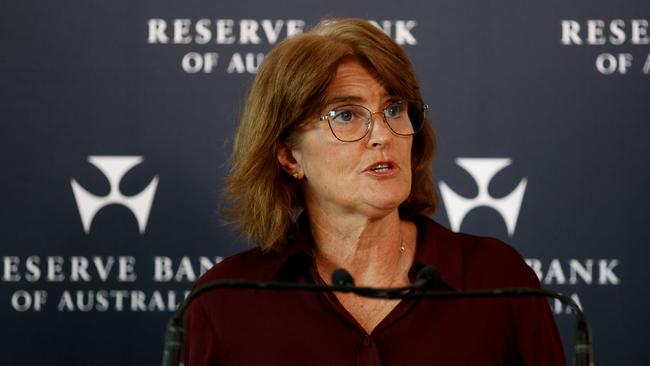Markets soar as RBA considered rate hike but stays ‘neutral’
RBA governor Michele Bullock has stared down calls for a restart of interest rate increases although she admits the board did consider it.

Reserve Bank governor Michele Bullock has stared down calls for a restart of interest rate rises, declaring that the central bank has a “neutral” policy outlook, although it did consider a rate increase this month.
While acknowledging that inflation is easing more slowly than expected after stronger than expected price pressures this year, the RBA board kept its cash rate target unchanged at a more than 12-year high of 4.35 per cent and maintained that it was “not ruling anything in or out” on rates.
In its post-meeting statement, the board repeated its previous expectation that it “will be some time yet before inflation is sustainably in the target range”, adding that it “will remain vigilant to upside risks” after core trimmed mean inflation for the March quarter rose 4 per cent.
The persistence of services inflation was a “key uncertainty” and “expected to ease more slowly than previously forecast”, reflecting stronger labour market conditions including a more gradual increase in the unemployment rate and the broader under-utilisation rate, the RBA board warned.
Updated RBA staff forecasts continued to show core inflation near the top of the 2-3 per cent target by the end of next year and the middle of the band by 2026. However, the recut forecasts were based on assumption of market pricing on the interest rate outlook. That implied “some chance of one more rate increase in Australia this year, with no reduction in the cash rate expected until 2025”.
Markets reacted positively as the RBA board didn’t turn overtly hawkish in its communications.
The sharemarket built on strong offshore leads, the S&P/ASX 200 surging 1.4 per cent to a near four-week high of 7793.3 points. The dollar fell about 0.6 per cent to a two-day low of US65.87c. Australia’s three-year bond yield fell 11 basis points to 3.92 per cent.
In her press conference, Ms Bullock confirmed that the board considered the case for lifting rates this month and the option of keeping rates unchanged, but that its policy outlook was “neutral”.
Policy was “currently restrictive” and if the board thought inflation was “going to be persistent and significantly above our forecast, we will tighten again”, Ms Bullock said. “But the board made the judgment at the meeting that the right stance at the moment is to continue to observe what’s going on in the economy, be data driven.”
NAB head of market economics Tapas Strickland said: “What surprised was the absence of a hawkish bias. While there is no explicit hiking bias, governor Bullock said that the RBA needed to be ‘alert and vigilant’ on inflation.”
Ms Strickland noted that one reason why the RBA needed to be vigilant was that it didn’t take much signal from the upward surprise from the March quarter CPI for future inflation outcomes.
The May statement on monetary policy noted that “forecast disinflation is guided by a suite of models that take some signal from the stronger-than-expected March quarter CPI outcome”.
However, the statement said it was “possible that more signal should be taken from the upside data surprise as it may suggest that there is more persistence or ‘stickiness’ in domestically determined components of the basket than currently assumed (which is not offset by the higher cash rate path assumption underpinning these forecasts)”.
NAB’s Mr Strickland said the RBA’s forecasts gave little leeway for additional upward inflation surprises.
Productivity growth is another risk, the RBA noting that “baseline forecasts include an assumption that labour productivity growth increases to the rate recorded in the decades preceding the pandemic … if productivity is weaker than assumed, businesses would face higher costs of producing a given amount of output, putting upward pressure on prices paid by consumer”.
Westpac said the RBA board was “balancing near-term inflation risks with a desire to avoid a recession”.
“While there have been upside surprises in recent inflation and labour market data, these occurred in a context of weak domestic demand and a trajectory for inflation that is still clearly downwards,” Westpac chief economist Luci Ellis said.
In her press conference, Ms Bullock said the board aimed to lower inflation to ensure inflation expectations remained well anchored, while not going so fast that it tipped the economy into recession. ANZ said Ms Bullock’s post-meeting statement was “less hawkish than we’d expected”, even as the RBA’s near-term upward revisions to the inflation forecasts were larger than expected.
The RBA saw headline inflation ending the year at 3.8 per cent, versus 3.6 per cent in the March quarter.
ANZ’s head of Australian economics, Adam Boyton, said the lack of overtly hawkish language from the RBA despite larger than expected upward revisions to its inflation forecasts over the next few quarters implied the hurdle to another rate rise “could be higher than markets have been expecting”.
According to Capital Economics, the RBA’s decision to leave rates unchanged despite a material upside surprise in the CPI data “suggests that the bar for a resumption of rate hikes is high”.
“However, the other side of that coin is that the bank will probably need to see several more months of soft data before it is confident that it can loosen policy settings,” Capital Economics economist Adhijit Surya said. “All told, cuts will likely take longer to materialise than most anticipate.
“We now think that the RBA won’t hike rates any further.”
Capital Economics was the only forecaster that predicted a rate rise this month.




To join the conversation, please log in. Don't have an account? Register
Join the conversation, you are commenting as Logout